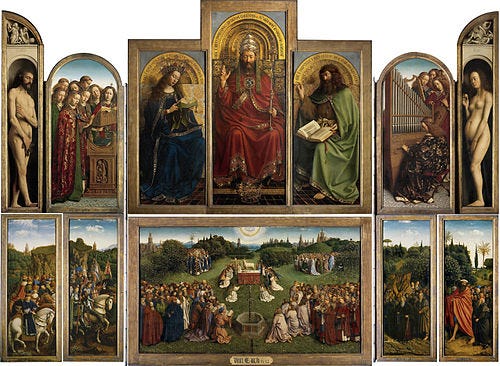Birthday Dinner Conversation...
Books, the Ghent Altarpiece, the Fibonacci Sequence, and the Dunning-Kruger Effect...
the twelve interior panels of the Ghent Altarpiece
I took two of my nieces out for their birthdays this weekend. We went to Barnes and Noble first. Katie got two books, Between Shades of Gray, not to be confused with Fifty Shades of Gray! and The Girl with The Louding Voice. Bridget got a calligraphy set. I’ve been promised a ‘thank you’ card written in calligraphy.
The conversation during dinner covered a lot of ground.
Bridget posed a good question: what fairy tales would you prefer to read- Hans Christian Anderson or The Brothers Grimm? They came to no decision on that one. Katie said she needed to think about it.
Apparently the Ghent Altarpiece is the most stolen artwork. According the piece in The Guardian, the Ghent Altarpiece, also known as the Adoration of the Mystic Lamb
has been nearly burned by rioting Calvinists, stolen by Napoleon for the Louvre in Paris, cut in half after falling into the hands of the King of Prussia, coveted by Hermann Göring and taken by Adolf Hitler before being rescued by a team of commando double-agents from an Austrian salt mine where it was destined to be blown apart with dynamite.
It has not survived entirely unscathed. One of its 12 panels remains missing after a daring heist on the evening of 10 April 1934, which has since baffled police detectives, bemused amateur sleuths and driven to despair the Nazi agents ordered by Goebbels to find it as a gift for the German Führer.
The new climate controlled glass-case home is meant to protect the painting from the elements and from art thieves. I have no doubt that the art thieves have already begun to try to find a way to steal this masterpiece.
Next up on the chat agenda was the Fibonnaci Sequence, some math thing, as Bridget called it. The Fibonacci numbers form a sequence such that each number is the sum of the two preceding ones, starting from 0 and 1. I can’t remember now why the Fibonacci Sequence was brought up. But it led to our next topic….
The Dunning-Kruger Effect, a psychological phenomena of “illusory superiority” in those with low or limited ability and in illusory inferiority in those of high ability.
According to wikipedia, in the original study,
the psychological phenomenon of illusory superiority was identified as a form of cognitive bias in Kruger and Dunning's 1999 study "Unskilled and Unaware of It: How Difficulties in Recognizing One's Own Incompetence Lead to Inflated Self-Assessments". The identification derived from the cognitive bias evident in the criminal case of McArthur Wheeler, who, on April 19, 1995, robbed two banks while his face was covered with lemon juice, which he believed would make it invisible to the surveillance cameras. This belief was based on his misunderstanding of the chemical properties of lemon juice as an invisible ink.
Apparently, aware that lemon juice could be used to make invisible ink, Wheeler thought that by smearing lemon juice on his face he’d be invisible to the security cameras. He tested his theory by covering his face with the juice and taking a polaroid. No image showed on the picture so off he went, lemon juice all over his face. His face burned, his eyes stung, he had trouble seeing, but he plowed ahead, going to two Pittsburgh bank, gun in hand, demanding money. After the robberies, the police released the camera footage of the robberies. Within an hour of the broadcast, the-not-invisible Wheeler was identified and arrested. As the police were taking him away, he signed, “but I wore the juice.”
All in all, Katie and Bridget were fantastic dinner companions.



